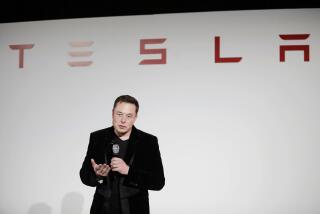Who Cheers Eisner’s Payout? Disney Shareholders
The typical public reaction to last week’s news of Michael Eisner’s $197-million payout from stock options was negative. “It’s obscene. Nobody’s worth that kind of money,” said an attorney when told the income of Walt Disney Co.’s chairman.
Even top business executives were qualified in their responses. “A deal’s a deal,” said one corporate chieftain, citing the fact that Eisner’s now-valuable options date to 1984, when he took the helm at Disney. Most executives feared that Eisner’s compensation, and the $60 million gained in stock options by Disney President Frank Wells, would arouse political reaction from the incoming Clinton Administration, which is already committed to limiting executive incentives.
But many shareholders were unequivocal in their approval. “He deserves every penny,” a pension fund manager said of Eisner, “He’s the best thing that happened to the company since Mickey Mouse.”
It may seem outrageous, but the shareholders are on the right track. And if we understand why--and how incentive pay can be done even better than at Disney--we may get a handle on improving a lot of U.S. companies.
Shareholders are cheering the tenfold increase in Disney’s stock price since 1984, from the equivalent of $4 a share to more than $40 at present, from roughly $2 billion in market value to more than $20 billion.
And they’re cheering the way Eisner, 50, earned his monumental gains. When Eisner was recruited from Paramount--where he was chief operating officer--to run then-troubled Disney, he accepted a compensation package that emphasized incentives. He got, and still receives today, the same $750,000 yearly salary he had at Paramount--a big wage, of course, but not high by chief executive standards--plus the promise of bonuses if Disney’s profits met targets for return on investment. And he got long-term stock options, which would attain value if the company prospered and the stock rose.
“The targets he had to meet were higher than other company bosses in the entertainment business,” says Graef Crystal, the compensation specialist and critic of most executives’ pay, who designed the Eisner package. The targets were also higher than those applied in many other companies where the only rising numbers are for layoffs and the boss’s paycheck.
“There’s enormous variability in his pay package,” says a major pension investor, “and that’s the way it should be--if Disney does poorly, Eisner does poorly.”
Disney has not done poorly. A company threatened with takeover and breakup in 1984, Disney’s revenues have more than trebled to $7 billion since then. Earnings per share have gone from 4 cents to $1.52 in the fiscal year to Sept. 30.
Eisner has expanded theme parks, financed them adroitly, rebuilt film operations and maximized the legacy of Walt Disney. Major shareholders, such as Sid R. Bass and his group of investors who own 18.5% of the stock, have made $900 million. Roy Disney and Sharon Disney Lund--Walt’s nephew and daughter and company directors--have made at least $75 million each.
But the larger story is that 503 pension funds, which own about 42% of Disney, have made money too. Pensions in other companies are more secure because of Disney’s performance, and expansion has doubled the number of Disney employees.
Eisner didn’t do it alone, though. Disney has 58,000 employees, but only 1,000 of them--executives making $80,000 and more--enjoy stock options. There are bonuses for 2,000 other managers and a 401(k) pretax savings plan for 12,000 salaried personnel. So incentives apply to roughly 22% of all employees. “The theory is that you motivate the people who whip the galley slaves,” Crystal remarks.
But it’s just that kind of theorizing that makes the public scornful of corporate America and has Congress ready to pounce, as it is now. In fact, Eisner and Wells--rightly or wrongly-- cashed in their stock options last week expressly to avoid tax changes Clinton has pledged to make.
Measures to limit deductibility of incentive pay from corporate taxes--an attempt to curb executive pay--passed both houses of Congress last session, but were vetoed by President Bush. President Clinton will probably sign such measures.
But it’s a stupid idea. Compensation specialists will find a way around restrictions, possibly by increasing non-cash perquisites such as company houses and cars--a pattern that breeds corporate mediocrity in Europe and Japan, and would only increase it here.
The better way to motivate Americans would be to truly encourage individual effort by spreading incentives down through a company’s rank and file. If officers dine on caviar, why must foot soldiers get C-rations?
In fact, some companies already offer stock options to all employees, says John McMillan, of the consulting firm William M. Mercer Co. “And they tend to be among the fastest growing,” says McMillan, who mentions PepsiCo--a stock that has risen eight-fold in a decade. He also cites Compaq Computer, Adobe Systems and others.
Pfizer, the pharmaceutical company, has stock incentives for all its employees, too. And a skeptic once asked now-retired Chairman Edmund Pratt how “stock options for janitors” could really affect Pfizer stock? “It couldn’t hurt,” Pratt replied, “if every employee went home at night and looked at that stock price as connected to his or her job.”
Even so, Eisner’s payout is huge--and it has caused many Americans to ask, “Isn’t it really too much?” One answer is that if Eisner had taken his stock gains gradually over the years, they would have been simply routine.
But the best reply to the “too-much” question is a tougher-minded one, asked by Disney shareholder and corporate activist Nell Minow last week: “If it’s pay for performance, why shouldn’t the sky be the limit?” Why indeed?
Columnist Allan Sloan says Eisner’s new wealth may qualify him for the Forbes 400 list of richest Americans. D5
More to Read
The biggest entertainment stories
Get our big stories about Hollywood, film, television, music, arts, culture and more right in your inbox as soon as they publish.
You may occasionally receive promotional content from the Los Angeles Times.










